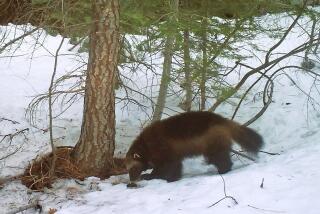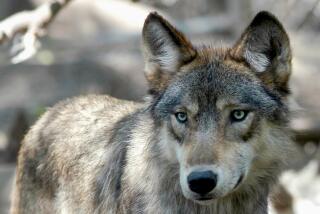Sierra Nevada bighorn sheep transported to their historical range
Bighorn sheep are skilled mountain climbers. But one group recently made it over the Sierra Nevada crest in record time.
As part of an ongoing effort to return endangered Sierra Nevada bighorns to more of their historical range, state and federal wildlife workers captured 14 of the animals in the Inyo National Forest and transported them by helicopter to the Big Arroyo area of Sequoia National Park on the range’s west side.
The four rams and 10 ewes, all but one of which was pregnant, were moved in late March to a part of the Sierra that bighorns have not occupied for more than a century.
Before settlement, more than 1,000 of the animals are thought to have roamed high elevations of the range from Sonora Pass in the north to Olancha Peak in the south.
Their numbers plunged when ranchers started grazing domestic sheep in the Sierra, spreading disease to the bighorn herds. Commercial hunting also contributed to their decline, and by the 1970s only three herds could be found in some of the steepest and most rugged portions of the Eastern Sierra.
Sierra Nevada and desert bighorns are the two bighorn subspecies found in California. The Sierra population has grown to about 500 animals from a low of roughly 100 in 1995.
Last month’s operation took place over several days. Workers with the California Department of Fish and Wildlife captured the bighorns one at a time by dropping a net over them from a helicopter.
The animals, which sport large curling horns, were blindfolded, hobbled and transported to a processing site. Each sheep was examined and fitted with a radio collar and a GPS collar.
They were trucked in aluminum boxes down Highway 395 to near Lone Pine and then flown about 25 miles over the crest to the release site.
Although rams can weigh more than 200 pounds and females more than 100 pounds, the bighorns were not sedated after their capture. Instead they were kept calm with blindfolds and hobbles.
Both were removed for the helicopter ride, and when the boxes were opened to let the sheep scamper into their new home, “they’re all just lying in there like there’s nothing in the world wrong,” said Tom Stephenson, leader of the Sierra Nevada Bighorn Sheep Recovery Program.
Despite the drought, Stephenson said there is adequate forage and water for the sheep in their high-elevation habitat. And the low snowpack has eliminated the danger of deep snow and avalanches.
More to Read
Start your day right
Sign up for Essential California for news, features and recommendations from the L.A. Times and beyond in your inbox six days a week.
You may occasionally receive promotional content from the Los Angeles Times.







